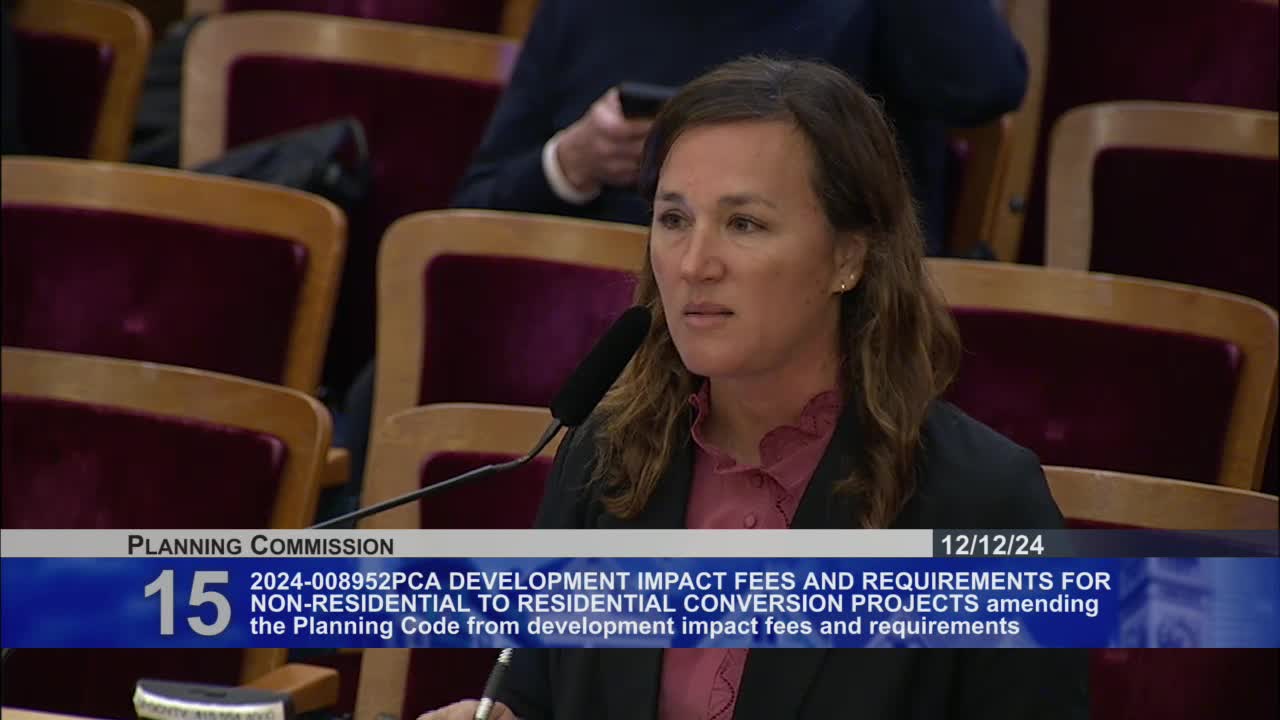San Francisco adapts commercial sites to residential housing with new financial incentives
December 12, 2024 | San Francisco City, San Francisco County, California
This article was created by AI summarizing key points discussed. AI makes mistakes, so for full details and context, please refer to the video of the full meeting. Please report any errors so we can fix them. Report an error »

The San Francisco City Council meeting on July 4, 2025, focused on the city's ongoing efforts to revitalize downtown through adaptive reuse of commercial buildings. Key discussions centered on a proposed ordinance aimed at easing the conversion of nonresidential spaces into residential units, particularly in designated C2 and C3 districts.
To qualify for the program, developers must replace a nonresidential use with residential use in specific areas of the city. The ordinance proposes significant financial incentives, including waivers for development impact fees and inclusionary housing requirements, potentially covering up to 110% of these costs. For instance, if a developer converts a 10,000 square foot building, they would not incur fees on the entire space if they expand it.
The city has already made strides in addressing regulatory barriers through previous legislation, which waived requirements related to lot coverage, open space, and unit exposure. In response to feedback from a recent request for interest (RFI) on adaptive reuse projects, the city acknowledged three main financial barriers: real estate transfer tax, property tax, and development impact fees.
In March, voters approved Proposition C, which eliminates the real estate transfer tax for the first 5 million square feet of commercial-to-housing conversions. Additionally, Assembly Bill 2488 allows the creation of a special financing district to reinvest property tax revenue into these projects, further supporting their financial viability.
The department overseeing these initiatives proposed three technical modifications to the ordinance to ensure consistency with existing planning codes and to clarify eligibility criteria. The commission is expected to review and potentially adopt these recommendations, with local legislation to support the new measures anticipated next year.
The meeting concluded with an invitation for public comment, allowing community members to voice their opinions on the proposed changes. The city's efforts reflect a commitment to enhancing downtown living and addressing housing shortages through innovative reuse of existing structures.
To qualify for the program, developers must replace a nonresidential use with residential use in specific areas of the city. The ordinance proposes significant financial incentives, including waivers for development impact fees and inclusionary housing requirements, potentially covering up to 110% of these costs. For instance, if a developer converts a 10,000 square foot building, they would not incur fees on the entire space if they expand it.
The city has already made strides in addressing regulatory barriers through previous legislation, which waived requirements related to lot coverage, open space, and unit exposure. In response to feedback from a recent request for interest (RFI) on adaptive reuse projects, the city acknowledged three main financial barriers: real estate transfer tax, property tax, and development impact fees.
In March, voters approved Proposition C, which eliminates the real estate transfer tax for the first 5 million square feet of commercial-to-housing conversions. Additionally, Assembly Bill 2488 allows the creation of a special financing district to reinvest property tax revenue into these projects, further supporting their financial viability.
The department overseeing these initiatives proposed three technical modifications to the ordinance to ensure consistency with existing planning codes and to clarify eligibility criteria. The commission is expected to review and potentially adopt these recommendations, with local legislation to support the new measures anticipated next year.
The meeting concluded with an invitation for public comment, allowing community members to voice their opinions on the proposed changes. The city's efforts reflect a commitment to enhancing downtown living and addressing housing shortages through innovative reuse of existing structures.
View full meeting
This article is based on a recent meeting—watch the full video and explore the complete transcript for deeper insights into the discussion.
View full meeting
